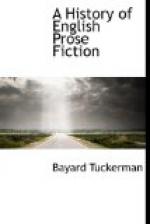“God defend us!” said Edmund; “but I verily believe that the person that owned this armor lies buried under us.” Upon this a dismal, hollow groan was heard, as if from underneath. A solemn silence ensued, and marks of fear were visible upon all three; the groan was thrice heard.
To the average mind of the present day Clara Reeve’s ghost is not less improbable and incredible than Walpole’s gigantic helmet. If the reader is prepared by the poetic nature of a narrative for the influence of the supernatural, he will receive all marvels with equal ease; but if he be not prepared, if his mind be occupied during the greater part of the work with actual and ordinary occurrences, any supernatural event is rejected. Miss Reeve introduced far less of the incredible than her predecessor, but she did not approach Walpole in the adaptation of her scenes to supernatural effects. It requires less imagination to see a figure walk out of a portrait in the gloomy castle of Otranto, than to hear the groan of Miss Reeve’s spectre.
The incompatibility of the real and the unreal in the same work is sufficiently shown by the course pursued by the different writers who took part in the romantic revival. Walpole had boldly introduced a skeleton monk, and had crushed one of his characters by a gigantic helmet which fell from the sky. Clara Reeve’s sense of congruity was shocked by so strong a contrast between the usual and the extraordinary, and therefore limited herself to a single supernatural effect, which might inspire fear while yet remaining within the bounds of superstitious credulity. The next and greatest contributor to the romantic revival still further modified the methods of her predecessors, and in so modifying them, testified her doubts of their efficacy. Mrs. Radcliffe’s plan was not to summon a spectre from his resting-place and to make him move among flesh and blood personages. She simply described the superstitious fears of her heroes and heroines, and sought to make her reader share in them. She excited the imagination by highly wrought scenes of horror, but instead of ascribing those scenes to the intervention of supernatural beings, she showed them to proceed from natural causes. The terror felt, by her fictitious characters and shared by the reader, was not so much inspired by real dangers from without, as by superstitious fear within. The following passage will illustrate Mrs. Radcliffe’s method of dealing with the supernatural:
From the disturbed slumber into which she then sunk, she was soon awakened by a noise, which seemed to arise within her chamber; but the silence that prevailed, as she tearfully listened, inclined her to believe that she had been alarmed by such sounds as sometimes occur in dreams, and she laid her head again upon the pillow.
A return of the noise again disturbed her, it seemed to come from that part of the room which communicated with the private staircase,




